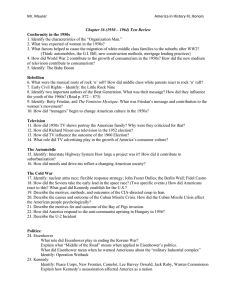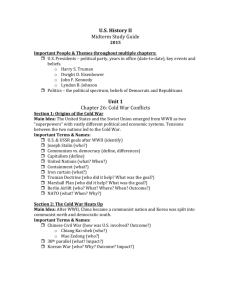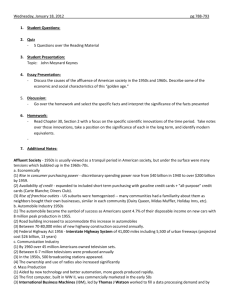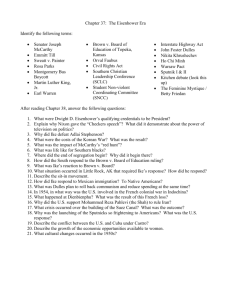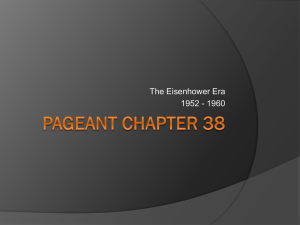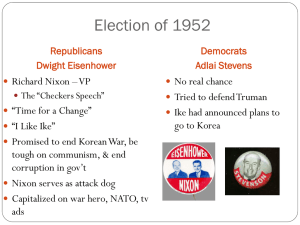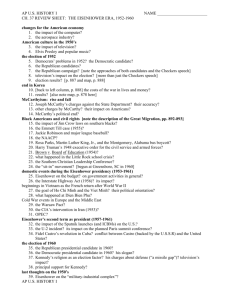Chapter 37
advertisement
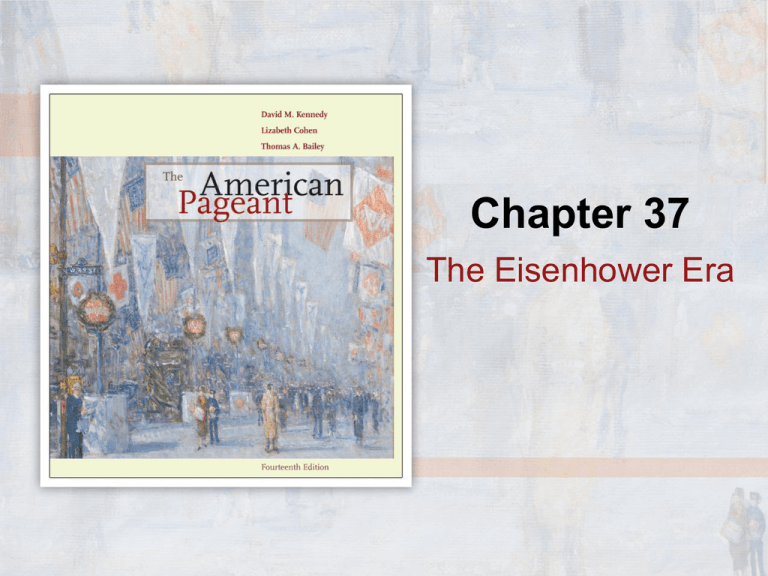
Chapter 37 The Eisenhower Era An Early Computer, ca. 1950 Just a few decades later, technological improvements would bring the computing power of this bulky behemoth to the user’s desktop. Women in the Labor Force, 1900–2005 Sources: Historical Statistics of the United States and Statistical Abstract of the United States, relevant years. The Booming Service Sector Services displaced manufacturing as the most dynamic area of the economy in the post–World War II era, and women made up a majority of new workers in the nation’s offices and classrooms and on sales floors and hospital wards. The Original Golden Arches, 1955 Maurice and Richard McDonald replaced their original drive-in hamburger stand in San Bernardino, California, with this double-arched design in 1953. McDonald’s soon became one of the largest franchised restaurant chains in the world and a global symbol of American consumerism. Households with Television Sets, 1946–2009 The King With his fleshy face, pouting lips, and antic, sexually suggestive gyrations, Elvis Presley became the high priest of rock ’n’ roll in the 1950s, to the chagrin of parents every where. Bloated by fame, fortune, and drugs, he died in 1977 at the age of forty-two. The Republicans’ Choice, 1952 Nominee Eisenhower and his vicepresidential running mate, Nixon, greet the delegates. Presidential Election of 1952 (with electoral vote by state) A Democrat quipped that “if the voters liked the Republicans the way they liked Ike, the two-party system would be in bad shape.” Fortunately for Democrats, Eisenhower scored a personal, not a party, victory. Republicans won minuscule majorities in Congress, which disappeared in the congressional elections two years later. Korean War Scene A grief-stricken American soldier whose buddy has been killed is being comforted, while a medical corpsman fills out casualty tags. A Popular President “Ike” exuded grandfatherly graciousness and goodwill. Senator McCarthy Extinguishes the Torch of Liberty While preaching patriotism, McCarthy irresponsibly menaced American traditions of civil liberties. The Face of Segregation These women in the segregated South of the 1950s were compelled to enter the movie theater through the “Colored Entrance.” Once inside, they were restricted to a separate seating section, usually in the rear of the theater. The Migration of the Negro, by Jacob Lawrence, 1940–1941 Artist Jacob Lawrence depicted the migration of southern blacks to the North during and after World War II in a series of paintings. The first panel of the series bears the description “During the World War there was a great migration north by southern Negroes.” The Home Front Though often confronted by prejudice and discrimination, many African American migrants from the rural South found their first industrial jobs in wartime defense plants during World War II. Detroit Race Riot, 1943 A black passenger is dragged from a streetcar. Integration at Little Rock, 1957 While white mobs jeered at the first black students entering Central High School, federal troops, with bayonets fixed, enforced the law. Integration at Little Rock, 1957 While white mobs jeered at the first black students entering Central High School, federal troops, with bayonets fixed, enforced the law. Martin Luther King, Jr., and His Wife, Coretta, Arrested King and his wife were arrested for the first time in Montgomery, Alabama, in 1955 while organizing the bus boycott. Operation Wetback Thousands of illegal Mexican immigrants were forcibly repatriated to Mexico in the federal government’s 1954 roundup operation, which was promoted in part by the Mexican government. The man in this photograph is being pulled across the border by a Mexican official, while an American spectator tries to pull him back into the United States. Drive-in Movie Theater, Utah, 1958 Going to the movies became one more thing Americans could do in their cars in the 1950s. Here moviegoers watch Charlton Heston as Moses in the Academy Award– winning motion picture The Ten Commandments. It was the last film made by famed director Cecil B. DeMille. Hungarian Uprising, October 26, 1956 Soviet tanks rolled through the streets of Budapest to crush an anticommunist uprising against the Soviets, who had controlled Hungary since World War II. This demonstration of brute force against a grassroots democratic movement turned many communist sympathizers in the West definitively against the Soviet Union. East and Southeast Asia, 1955– 1956 Egyptian President Gamal Abdel Nasser, 1954 Shown here greeting exuberant supporters after his election as the first president of the new Egyptian republic, Nasser was long a thorn in the flesh of American and European policymakers anxious to protect the precious oil resources of the Middle East. “Nassarism,” his version of pan-Arabism, won a great following in the Arab world during the 1950s and 1960s. The Helicopter Era, 1957 President Eisenhower was routinely criticized by liberals, as in this Herblock cartoon in the Washington Post, for his apparent indifference to many seething social problems of the day. His failure to employ his vast prestige on behalf of civil rights was especially conspicuous. What’s So Funny? 1960 Premier Khrushchev gloats over Ike’s spying discomfiture. John F. Kennedy Campaigning for the Presidency, 1960 At right is his wife, Jacqueline Kennedy. Presidential Election of 1960 (with electoral vote by state) Kennedy owed his hairbreadth triumph to his victories in twenty-six of the forty largest cities—and to Lyndon Johnson’s strenuous campaigning in the South, where Kennedy’s Catholicism may have been a hotter issue than his stand on civil rights. The Shopping Mall as New Town Square, 1960 Ernest Hemingway (1899–1961) Celebrated both for his writing and his colorful, swashbuckling lifestyle, Hemingway poses here with a dead leopard in 1953. Death of a Salesman First performed in 1949, Arthur Miller’s play probed the psychic costs of failure in a society that held out the promise of “success” to all. The play especially resonated with audiences in the booming 1950s and quickly took its place as an American classic. This scene from the original Broadway production shows Arthur Kennedy as Biff Loman (left) confronting his father, Willy, played by Lee J. Cobb (seated), while his brother, Happy, portrayed by Cameron Mitchell, looks on. Not shown here is Willy’s compassionate wife, Linda, brilliantly acted by Mildred Dunnock.

